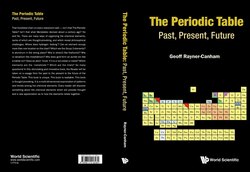Читать книгу The Periodic Table - Geoff Rayner-Canham - Страница 7
На сайте Литреса книга снята с продажи.
ОглавлениеContents
About the Author
Introduction
Chapter 0The Periodic Table Exploration Begins!
Reference
Chapter 1Isotopes and Nuclear Patterns
Proton–Neutron Ratio
The Cobalt–Nickel and Tellurium–Iodine Atomic Mass Anomalies
Nuclear Shell Model of the Nucleus
Limits of Stability
Commentary
References
Chapter 2Selected Trends in Atomic Properties
Electronegativity
Electron Gain and Loss
Ionization Energy
Electron Affinity
Relativistic Effects on Atomic Properties
Commentary
References
Chapter 3First Period Problems
Hydrogen Location: An Overview
… And Then There Is Helium
Commentary
References
Chapter 4The Group 3 Problem
A History of the Debate
Commentary
References
Chapter 5Categorizations of the Elements
Nonmetals, Metals, and “In-Betweens”
Main Group Appellations
d-Block Metal Appellations
Other Appellations
Commentary
References
Chapter 6Isoelectronicity
Historical Definitions of Isoelectronic
Modern Definitions of Isoelectronic
Isoelectronicity: The Future
Commentary
References
Chapter 7Group and Period Patterns among the Main Group Elements
Main Group Elements
Group Trends
Group 1 (Alkali Metals)
Group 2 (Alkaline Earth Metals)
Group 13 (Triels)
Group 14 (Tetrels)
Group 15 (Pnictogens)
Group 16 (Chalcogens)
Group 17 (Halogens)
Group 18 (Aerogens)
Periodic Trends
Commentary
References
Chapter 8Patterns among the Transition Metals
What Is a Transition Metal?
Previous Classifications of Transition Metals
Categorizations of the Transition Metals
Categorizing the Early 4d–5d Elements
The Platinum Metals
Is There, in Fact, a Group 11?
A Hybrid Solution
Commentary
References
Chapter 9Group (n) and Group (n + 10) Relationships
Going Back to the Past
Definition of the Group (n) and Group (n + 10) Relationship
Group 3 and Group 13
Group 4 and Group 14
Group 5 and Group 15
Group 6 and Group 16
Group 7 and Group 17
Group 8 and Group 18
Group 1 and Group 11
Group 2 and Group 12
A Curious (n + 5) and (n + 10) Case
Commentary
References
Chapter 10Chemical “Knight’s Move” Relationship
The Group (n)/Period (m) and Group (n + 2)/Period (m + 1) Linkages
Laing’s Knight’s Move (K-M) Claims
Reevaluation of the Knight’s Move Relationship
Knight’s Move Relationships among “Double Pairs”
The Knight’s Move Relationship and the “Inert Pair” Effect
Commentary
References
Chapter 11Isodiagonality
Isodiagonality
Explanations for Isodiagonality
Isodiagonality of Lithium and Magnesium
Isodiagonality of Beryllium and Aluminum
Isodiagonality of Boron and Silicon
Isodiagonality of Carbon and Phosphorus
Isodiagonality of Nitrogen and Sulfur
Isodiagonality of Vanadium and Molybdenum
Isodiagonality of Tellurium and Astatine
Evidence-Based Isodiagonality
Commentary
References
Chapter 12Lanthanoids, Group 3, and Their Connections
Yttrium and Scandium
The 4f Elements
The Lanthanoids
Ion Charges of the Lanthanoids
Restructuring the Lanthanoids
External Lanthanoid Relationships
Commentary
References
Chapter 13Actinoid and Post-Actinoid Elements
The Actinoid Elements
Oxidation States of the Actinoids
Post-Actinoid Elements
And Beyond …
Commentary
References
Chapter 14Pseudo-Elements
Pseudo-Elements
Pseudo-Halogens
Combo Elements
Superatoms
Synthetic Metals
Commentary
References
Index
